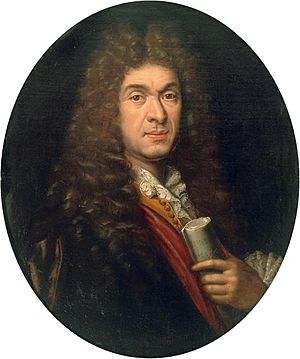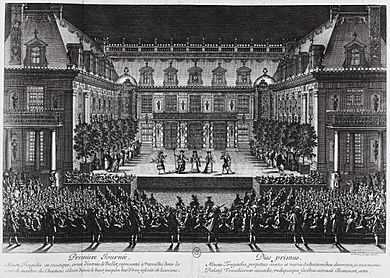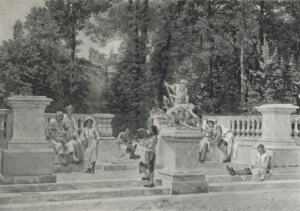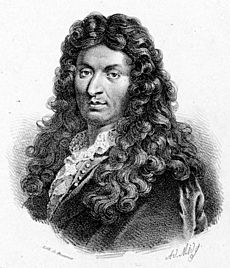Jean-Baptiste Lully facts for kids
Quick facts for kids
Jean-Baptiste Lully
|
|
|---|---|
 |
|
| Born |
Giovanni Battista Lulli
November 28, 1632 Florence, Grand Duchy of Tuscany (now Italy)
|
| Died | March 22, 1687 (aged 54) Paris, France
|
| Nationality | French |
| Occupation | Composer, guitarist, violinist, dancer |
| Spouse(s) | Madeleine Lambert |
| Children | Louis, Jean-Baptiste, and Jean-Louis |
Jean-Baptiste Lully was a famous composer, guitarist, violinist, and dancer. He was born Giovanni Battista Lulli in Florence, Italy, in 1632. Lully later became a French citizen. He is known as a master of the French Baroque music style.
Lully spent most of his life working for King Louis XIV. He was a close friend of the famous playwright Molière. They worked together on many comédie-ballets, which combined theater, music, and dance. Some of their well-known works include L'Amour médecin and Le Bourgeois gentilhomme.
Contents
Life Story
Jean-Baptiste Lully was born on November 28, 1632, in Florence, Italy. We don't know much about his early music lessons. He often said a monk taught him guitar. He also learned to play the violin.
In 1646, when Lully was 14, he was noticed by a French nobleman. Lully was dressed as a clown for Mardi Gras and was playing his violin. The nobleman took Lully to Paris, France. There, Lully worked for a princess named Mademoiselle de Montpensier. He probably improved his music skills by working with her household musicians. People quickly called him "Baptiste" and "the great street-artist" because he was so talented.
In 1652, the princess was sent away from Paris. Lully asked to leave her service because he did not want to live in the countryside. The princess agreed.
By 1653, Lully had caught the eye of the young King Louis XIV. They even danced together in a royal ballet. In March 1653, Lully became a royal composer for instrumental music. His music for court ballets made him very important to the king.
In 1661, King Louis XIV made Lully the head of all royal music. Lully became a French citizen in December 1661. He married Madeleine Lambert in 1662. Her father was a famous singer and composer.
From 1661, Lully's music for the court was published. In 1653, King Louis XIV made him director of his personal violin orchestra. This group was called the Petits Violons (Little Violins). They were open to Lully's new ideas. The older, larger orchestra, the Grands Violons (Great Violins), slowly started to follow Lully's lead.
Lully started working with the playwright Molière in 1661. Their first big collaboration was Le Mariage forcé in 1664. They worked together on many plays. These plays were often performed for the royal court. They sometimes had amazing special effects.
In 1672, Lully stopped working with Molière. Lully then became the director of the Paris Opera, which was the royal opera house. Between 1673 and 1687, he created a new opera almost every year. He worked hard to protect his control over this new type of music.
Lully died from a serious infection in 1687. He had accidentally hit his foot with his long conducting staff during a performance. He refused to have his leg removed, which led to the infection spreading. He was buried in Paris. All three of his sons became musicians.
Lully was highly praised after his death. People called him "the prince of French musicians." They said he invented "that beautiful and grand French music" like operas. He was seen as the father of many famous musicians who followed him.
Music Style and Influence
Lully's music was from the Middle Baroque period (1650 to 1700). Baroque music often uses a basso continuo, which is a strong bass line that drives the music.
Lully's music is known for being powerful and lively in fast parts. It also has deep feelings in slower parts. Some of his most popular pieces are his passacaglias and chaconnes. These are dance movements found in many of his works, like Armide.
Lully's music changed how court dances were performed. Before him, dances were slow and formal. He brought in lively ballets with fast rhythms. These were often based on popular dance types like gavottes, menuets, and sarabandes.
Working with Molière, Lully helped create a new music form called the comédie-ballet. This combined theater, comedy, music, and ballet. These plays were very popular. Lully's operas were also successful and spread beyond France. This helped to shape how orchestras were organized and how music was performed.
The instruments in Lully's music included five parts of strings, like violins, violas, and cellos. He also used guitars, lutes, harpsichords, organs, oboes, bassoons, recorders, flutes, brass instruments (like trumpets), and various percussion instruments (like castanets).
Lully is often given credit for bringing new instruments into the orchestra. However, he preferred older instruments like recorders over newer flutes. The "hautbois" he used were also a mix between older and newer oboes.

Lully created French-style opera, called tragédie en musique. He believed Italian opera was not right for the French language. So, he and his writer, Philippe Quinault, used the same style of poetry as spoken plays. This made the singing in Lully's operas sound very natural to people at the time.
Unlike Italian operas, Lully's operas focused on the story and drama. They used a mix of singing styles, not just separate songs and spoken parts. The chorus and dancers also played a big role, creating amazing scenes with special stage effects. Lully's operas also included many instrumental pieces like French overtures and dance tunes. These pieces were very influential across Europe.
Lully's Works
Lully composed many different types of music.
Sacred Music
Lully wrote grand motets for the royal chapel. These were often settings of psalms. He also wrote smaller motets, possibly for nuns.
- Miserere, 1664
- Te Deum, 1677
- De profundis, 1683
- Dies irae, 1683
- Domine salvum fac regem, 1687
Ballets for the Court
Lully's ballets for the court changed a lot as he started dancing and composing for them. He wrote overtures, dances, and songs for these ballets. He also experimented with different musical ideas that he later used in his operas.
- Ballet du Temps, 1654
- Ballet des plaisirs, 1655
- L'Amour malade, 1657
- Ballet royal d'Alcidiane, 1658
- Ballet de la Raillerie, 1659
- Ballet royal de l'impatience, 1661
- Ballet des Saisons, 1661
- Ballet des Arts, 1663
- Les Amours déguisés, 1664
- Ballet royal de la Naissance de Vénus, 1665
- Ballet des Muses, 1666
- Le Carneval, mascarade, 1668
- Ballet royal de Flore, 1669
- Le Triomphe de l'Amour, 1681
- Le Temple de la Paix, 1685
Music for Plays (Intermèdes)
Intermèdes were musical parts added to plays. They became a key part of the new comédie-ballet style. Lully's intermèdes were very detailed and reached their peak with works like Le Bourgeois gentilhomme in 1670.
- Les Fâcheux, 1661
- Le Mariage forcé, 1664
- Les Plaisirs de l'Ile enchantée, 1664
- L'Amour médecin, 1665
- La Pastorale comique, 1667
- Le Sicilien, 1667
- Le Grand Divertissement royal de Versailles (Georges Dandin), 1668
- Le Divertissement de Chambord (Monsieur de Pourceaugnac), 1669
- Le Bourgeois gentilhomme, 1670
- Psyché, 1671
- Les Fêtes de l'Amour et de Bacchus, 1672
- Idylle sur la Paix, 1685
- Acis et Galatée, 1686
Operas

Most of Lully's operas were called tragédie mise en musique, meaning "tragedy set to music." He worked closely with the writer Philippe Quinault on the stories. Lully tried to make the singing sound like natural speech, which was very important for French opera.
Unlike Italian operas of the time, Lully's operas focused on the story and used many different types of singing and chorus parts. The plots often ended with a grand scene involving solo singers, the chorus, and dancers. These scenes used amazing stage machinery.
- Cadmus et Hermione, 1673
- Alceste ou le Triomphe d'Alcide, 1674
- Thésée, 1675
- Atys, 1676
- Isis, 1677
- Psyché, 1678
- Bellérophon, 1679
- Proserpine, 1680
- Persée, 1682
- Phaëton, 1683
- Amadis, 1684
- Roland, 1685
- Armide, 1686
- Achille et Polyxène, 1687
Images for kids
See also
 In Spanish: Jean-Baptiste Lully para niños
In Spanish: Jean-Baptiste Lully para niños





